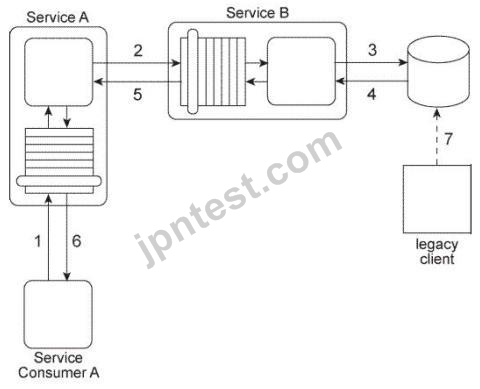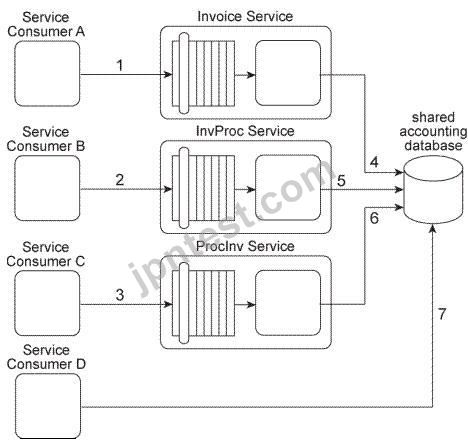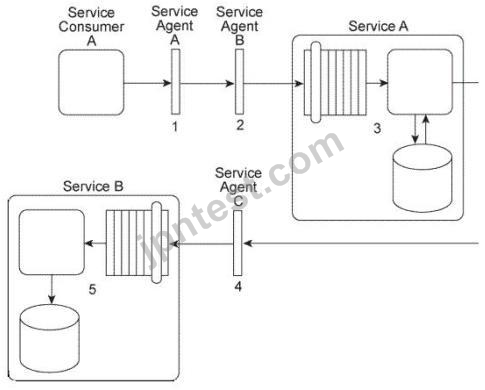S90.09 無料問題集「SOA Design & Architecture Lab」
Service A is an entity service that provides a Get capability that returns a data value that is
frequently changed.
Service Consumer A invokes Service A in order to request this data value (1). For Service
A to carry out this request, it must invoke Service B (2), a utility service that interacts (3.4)
with the database in which the data value is stored. Regardless of whether the data value
changed, Service B returns the latest value to Service A (5), and Service A returns the
latest value to Service Consumer A (6).
The data value is changed when the legacy client program updates the database (7) When
this change happens is not predictable. Note also that Service A and Service B are not
always available at the same time.
Any time the data value changes. Service Consumer A needs to receive it as soon as
possible. Therefore, Service Consumer A initiates the message exchange shown in the
Figure several times a day. When it receives the same data value as before, the response
from Service A is ignored. When Service A provides an updated data value, Service
Consumer A can process it to carry out its task.

The current service composition architecture is using up too many resources due to the
repeated invocation of Service A by Service Consumer A and the resulting message
exchanges that occur with each invocation. What steps can be taken to solve this problem?
frequently changed.
Service Consumer A invokes Service A in order to request this data value (1). For Service
A to carry out this request, it must invoke Service B (2), a utility service that interacts (3.4)
with the database in which the data value is stored. Regardless of whether the data value
changed, Service B returns the latest value to Service A (5), and Service A returns the
latest value to Service Consumer A (6).
The data value is changed when the legacy client program updates the database (7) When
this change happens is not predictable. Note also that Service A and Service B are not
always available at the same time.
Any time the data value changes. Service Consumer A needs to receive it as soon as
possible. Therefore, Service Consumer A initiates the message exchange shown in the
Figure several times a day. When it receives the same data value as before, the response
from Service A is ignored. When Service A provides an updated data value, Service
Consumer A can process it to carry out its task.

The current service composition architecture is using up too many resources due to the
repeated invocation of Service A by Service Consumer A and the resulting message
exchanges that occur with each invocation. What steps can be taken to solve this problem?
正解:D
解答を投票する
Our service inventory contains the following three services that provide invoice-related data
access capabilities: Invoice, InvProc, and Proclnv. These services were created at different
times by different project teams and were not required to comply to any design standards.
Therefore each of these services has a different data model for representing invoice data.
Currently each of these three services has one service consumer: Service Consumer A
accesses the Invoice service(1). Service Consumer B (2) accesses the InvProc service,
and Service Consumer C (3) accesses the Proclnv service. Each service consumer
invokes a data access capability of an invoice-related service, requiring that service to
interact with the shared accounting database that is used by all invoice-related services (4,
5, 6).
Additionally, Service Consumer D was designed to access invoice data from the shared
accounting database directly (7), (Within the context of this architecture. Service Consumer
D is labeled as a service consumer because it is accessing a resource that is related to the
illustrated service architectures.)

Assuming that the Invoice service, InvProc service, and ProcInv service are part of the
same service inventory, what steps would be required to fully apply the Official Endpoint
pattern?
access capabilities: Invoice, InvProc, and Proclnv. These services were created at different
times by different project teams and were not required to comply to any design standards.
Therefore each of these services has a different data model for representing invoice data.
Currently each of these three services has one service consumer: Service Consumer A
accesses the Invoice service(1). Service Consumer B (2) accesses the InvProc service,
and Service Consumer C (3) accesses the Proclnv service. Each service consumer
invokes a data access capability of an invoice-related service, requiring that service to
interact with the shared accounting database that is used by all invoice-related services (4,
5, 6).
Additionally, Service Consumer D was designed to access invoice data from the shared
accounting database directly (7), (Within the context of this architecture. Service Consumer
D is labeled as a service consumer because it is accessing a resource that is related to the
illustrated service architectures.)

Assuming that the Invoice service, InvProc service, and ProcInv service are part of the
same service inventory, what steps would be required to fully apply the Official Endpoint
pattern?
正解:D
解答を投票する
Service Consumer A sends a message to Service A.
Before the message arrives with Service A, it is intercepted by Service Agent A (1). which checks the message for
compliance to Policy A that is required by Service A.
If the message fails compliance, Service Agent A will not allow it to proceed and will instead write the message contents to a
log. If the message does comply to the policy, it continues to be transmitted toward Service
A, but before it arrives it is intercepted by Service Agent B (2), which validates the security
credentials in the message header. If the security credential validation fails, the message is
rejected and a runtime exception is raised. If the security credentials are validated, the
message is sent to Service A.
Upon receiving the message, Service A retrieves a data value from a database and
populates the message header with this data value (3) prior to forwarding the message to
Service B.
Before the message arrives at Service B.
it is intercepted by Service Agent C (4) which checks the message for compliance with two policies: Policy B and Policy C.
Policy
B is identical to Policy A that was checked by Service Agent A.
To check for compliance to Policy C.
Service Agent C uses the data value added by Service A.
If the message complies with both of the policies, it is forwarded to Service B (5), which stores the message contents in its own database.

You are told that Policy B and Policy C have changed. Also, in order to carry out the
compliance check of Policy C, Service Agent C will now require a new data value from the
Service B database. How can this service composition architecture be changed to fulfill
these new requirements?
Before the message arrives with Service A, it is intercepted by Service Agent A (1). which checks the message for
compliance to Policy A that is required by Service A.
If the message fails compliance, Service Agent A will not allow it to proceed and will instead write the message contents to a
log. If the message does comply to the policy, it continues to be transmitted toward Service
A, but before it arrives it is intercepted by Service Agent B (2), which validates the security
credentials in the message header. If the security credential validation fails, the message is
rejected and a runtime exception is raised. If the security credentials are validated, the
message is sent to Service A.
Upon receiving the message, Service A retrieves a data value from a database and
populates the message header with this data value (3) prior to forwarding the message to
Service B.
Before the message arrives at Service B.
it is intercepted by Service Agent C (4) which checks the message for compliance with two policies: Policy B and Policy C.
Policy
B is identical to Policy A that was checked by Service Agent A.
To check for compliance to Policy C.
Service Agent C uses the data value added by Service A.
If the message complies with both of the policies, it is forwarded to Service B (5), which stores the message contents in its own database.

You are told that Policy B and Policy C have changed. Also, in order to carry out the
compliance check of Policy C, Service Agent C will now require a new data value from the
Service B database. How can this service composition architecture be changed to fulfill
these new requirements?
正解:D
解答を投票する
